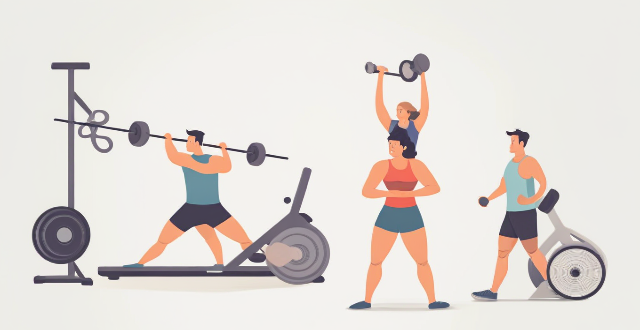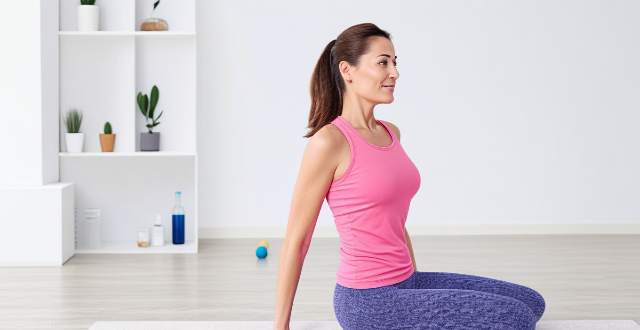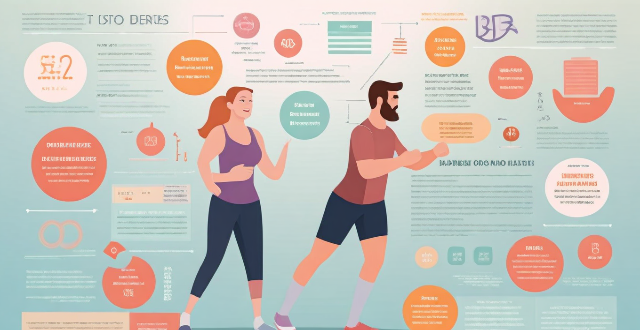Cardiovascular Strength

What is the difference between cardiovascular and resistance training in health management ?
The text discusses the differences between cardiovascular and resistance training, highlighting their unique benefits and examples of each. Cardiovascular training strengthens the heart, aids in weight management, and improves endurance, while resistance training enhances muscle strength, bone density, and metabolism. Combining both types of exercise leads to a well-rounded fitness regimen that addresses multiple aspects of health, including endurance, strength, flexibility, and balance. The text suggests ways to incorporate both forms of exercise into a workout routine for optimal health management.

What are the benefits of strength training ?
Strength training offers numerous benefits, including improved physical strength, boosted metabolism, enhanced bone density, better body mechanics and posture, mental health advantages, improved glucose control, reduced risk of chronic diseases, and increased independence. It is crucial for overall health and well-being.

Can strength training be part of a female fitness program ?
**Can Strength Training Be Part of a Female Fitness Program?** Yes, strength training is crucial for women's fitness programs. It offers benefits such as improved muscle tone, increased metabolism, enhanced bone density, and reduced injury risk. To integrate strength training effectively: start with light weights, focus on compound movements, balance it with cardio workouts, and consider professional guidance for personalized plans. This approach ensures a comprehensive and beneficial fitness regimen for women.

Is it better to do cardio or strength training for weight loss ?
When it comes to weight loss, both cardio and strength training have their benefits. Cardio exercises like running, cycling, and swimming can burn a significant number of calories in a short amount of time and improve cardiovascular health. Strength training helps build lean muscle mass, which raises your resting metabolic rate and burns more calories even at rest. While both types of exercise have their advantages, combining them into a well-rounded fitness routine is often the most effective approach for weight loss. A balanced routine that includes both cardio and strength training will improve various aspects of your fitness, including cardiovascular health, muscular strength, and flexibility.

What are the favorite exercises of popular celebrities ?
Celebrities have different preferences when it comes to exercise, but they all share a common goal of staying fit and healthy. Some popular exercises among them include yoga, Pilates, cardiovascular exercises, and weight training. Yoga is favored by Jennifer Aniston, Gwyneth Paltrow, and Madonna for its benefits on flexibility, strength, and balance. Pilates is preferred by Kim Kardashian, Vanessa Hudgens, and Kate Hudson for strengthening the core muscles and improving posture. Cardiovascular exercises like running, cycling, and swimming are enjoyed by Taylor Swift, Emma Stone, and Ryan Reynolds for burning calories and improving cardiovascular health. Weight training is popular among Dwayne "The Rock" Johnson, Chris Hemsworth, and Gal Gadot for building muscle mass and increasing strength. Overall, celebrities incorporate these activities into their daily routines to maintain their impeccable physique and overall well-being.

What are the best exercises for recovering from a sports injury ?
Recovering from a sports injury requires a combination of exercises that focus on flexibility, strength, cardiovascular fitness, stretching, and balance/coordination. Range of motion exercises help maintain joint flexibility, while strengthening exercises build muscle strength around the injured area. Cardiovascular exercises improve circulation and promote healing, while stretching exercises reduce stiffness and improve flexibility. Balance and coordination exercises improve stability and prevent future injuries. Incorporating these exercises into your rehabilitation program can speed up recovery and return to sport. It is important to consult with a physical therapist or healthcare professional before starting any new exercise program.

What role does muscle strength training play in preventing chronic diseases ?
Muscle strength training can help prevent chronic diseases such as heart disease, stroke, type 2 diabetes, and some types of cancer. It also has many benefits for physical and mental health, including improved cardiovascular health, weight management, better bone health, reduced risk of type 2 diabetes, enhanced mental health, increased self-esteem, improved physical function, lowered blood pressure, and cancer prevention. To get started with muscle strength training, it is important to start low and slow, mix up your routine, rest enough, stay hydrated, eat right, and get enough sleep. With dedication and consistency, you can achieve great results!

Is strength training safe for beginners ?
Strength training is a form of exercise that can provide numerous benefits, including increased muscle mass and strength, improved bone density, better body composition, reduced risk of injury, and enhanced athletic performance. However, it is essential to take safety measures to prevent injuries from improper technique or overexertion. Before starting any new exercise program, consult with a healthcare professional to ensure that you are healthy enough to participate. Start slowly and gradually increase intensity, focus on proper technique, warm up and cool down properly, and listen to your body. By following these tips, beginners can safely start strength training and enjoy its many benefits while minimizing the risk of injury.

What are some effective exercises for building strength and endurance in the water ?
Effective Water Exercises for Building Strength and Endurance Water exercises are a great way to build strength and endurance. They provide resistance that helps to tone muscles, improve cardiovascular health, and increase overall fitness levels. Here are some effective water exercises that you can try: 1. Swimming Laps 2. Water Aerobics 3. Resistance Training 4. High-Intensity Interval Training (HIIT) 5. Yoga in the Water Whether you prefer swimming laps, participating in water aerobics classes, resistance training, HIIT workouts, or yoga in the water, there's an option out there for everyone. So why not give it a try today?

Can exercise reduce the risk of developing cardiovascular diseases ?
Cardiovascular diseases (CVDs) are a leading cause of death worldwide, and regular physical activity or exercise is one of the most effective ways to reduce the risk of developing them. Exercise helps improve blood circulation, lower cholesterol levels, reduce inflammation, manage weight, and improve glucose control. The American Heart Association recommends at least 150 minutes per week of moderate-intensity aerobic activity or 75 minutes per week of vigorous-intensity aerobic activity, along with muscle-strengthening activities at least two days per week.

What role does cardiovascular exercise play in managing daily stressors ?
Cardiovascular exercise is an excellent way to manage daily stressors, as it reduces the body's physiological response to stress and leads to improved mental and physical health. The benefits of cardiovascular exercise include reduced stress levels, improved sleep quality, increased energy levels, and better mental health. To get started with cardiovascular exercise, set goals, start slow, find activities you enjoy, and mix up your workouts. Incorporating cardiovascular exercise into your daily routine can help you manage stress and improve overall well-being.

Can climate change lead to an increase in cardiovascular diseases ?
The article discusses the relationship between climate change and cardiovascular diseases, highlighting how extreme heat events, changes in air quality, and extreme weather patterns can contribute to an increase in heart-related illnesses. It explains how dehydration and electrolyte imbalances caused by heat stress can strain the heart, leading to chest pain, shortness of breath, and even heart failure. The article also points out that rising temperatures can cause pollutants like ozone and particulate matter to become more concentrated in the air we breathe, irritating the lungs and reducing oxygen uptake, which can strain the heart. Additionally, extreme weather events like hurricanes, floods, and wildfires can have both direct and indirect effects on cardiovascular health by causing physical trauma, stress, lack of access to medical care, and disruptions in medication adherence and continuity of care for those with chronic cardiovascular diseases. The article concludes by emphasizing the importance of taking steps to protect cardiovascular health, such as staying hydrated during hot weather, monitoring air quality, and having emergency plans in place for natural disasters.

Can strength training improve my posture ?
Strength training can significantly improve posture by addressing muscle balance, enhancing core strength, increasing body awareness, preventing future issues, and boosting confidence. This comprehensive approach not only corrects poor posture but also fosters overall health and well-being.

How much exercise do I need to maintain good cardiovascular health ?
Maintaining good cardiovascular health requires regular exercise, with the American Heart Association recommending at least 150 minutes of moderate-intensity aerobic activity or 75 minutes of vigorous-intensity aerobic activity each week, along with two or more days of muscle-strengthening activities. The amount of exercise needed may vary depending on individual needs and fitness level, and other lifestyle factors such as diet, stress management, sleep, and avoiding smoking and excessive alcohol consumption can also contribute to good cardiovascular health.

Can strength training help with weight loss ?
Strength training, involving the use of resistance to induce muscular contraction and build strength, can significantly contribute to weight loss by increasing metabolic rate, boosting post-exercise oxygen consumption (EPOC), improving body composition, and enhancing appetite control. Incorporating strength training into your routine, starting slowly and focusing on compound movements while staying consistent, can help achieve weight loss goals.

What exercises are beneficial for women's health ?
Regular physical activity is crucial for women's health, preventing chronic diseases, improving mental health, and boosting self-esteem. Aerobic exercises like running, swimming, and cycling are great for cardiovascular health and weight management. Strength training exercises such as weightlifting, resistance bands, and bodyweight exercises can improve bone density and reduce the risk of osteoporosis. Yoga helps to improve flexibility, reduce stress, and enhance mental clarity, while Pilates focuses on core strength, flexibility, and balance. Incorporating these exercises into a fitness routine can lead to improved cardiovascular health, stronger bones and muscles, reduced stress levels, and enhanced overall well-being.

Can strength training help improve my running performance ?
Strength training is an essential component of any fitness program, including running. It helps to build muscle strength and endurance, which can significantly improve your running performance. Strength training can help increase muscle strength and endurance, improve running economy, reduce the risk of injury, and enhance posture and body alignment. To incorporate strength training into your running routine, start slowly with light weights and gradually increase intensity over time. Choose exercises that target major muscle groups used during running, such as glutes, hamstrings, quadriceps, calves, and core muscles. Incorporate plyometric exercises to improve explosive power and acceleration. Allow sufficient recovery time between sessions to avoid overtraining and potential injuries.

What is the difference between strength training and bodybuilding ?
The text discusses the differences between strength training and bodybuilding, which are two popular forms of exercise. The main difference is that while both aim to improve physical fitness and appearance, strength training focuses on increasing muscular strength and endurance, whereas bodybuilding aims to build a well-defined, aesthetically pleasing physique. Techniques used in strength training include compound movements with heavy weights and low reps, while bodybuilding uses isolation exercises with moderate weights and high reps. The outcomes of strength training include increased strength and athletic performance, while bodybuilding leads to muscle growth and definition.

Does strength training have an impact on stress levels ?
Strength training can have a positive impact on stress levels through both physical and psychological benefits. It increases endorphin release, improves sleep quality, enhances self-esteem, provides distraction from stressors, fosters a sense of accomplishment, and promotes mindfulness. Consult with a healthcare professional before starting any new exercise regimen.

What are the best workout routines for women ?
The article provides a list of the best workout routines for women, including cardiovascular exercises like running, cycling, and swimming; strength training exercises like weight lifting, resistance bands, and bodyweight exercises; yoga and Pilates; high-intensity interval training (HIIT) like Tabata, circuit training, and jump rope; group fitness classes like Zumba, kickboxing, and barre; outdoor workouts like hiking, rock climbing, and stair climbing; and low-impact workouts like walking, elliptical machine, and rowing machine. These workouts can help women improve their overall fitness, strength, flexibility, balance, and cardiovascular health.

What are the best exercises for strength training ?
Strength training is essential for building muscle mass, increasing bone density, and improving overall physical performance. Here are some of the best exercises for strength training: 1. Barbell Squats 2. Deadlifts 3. Bench Press 4. Push-Ups 5. Pull-Ups 6. Lunges 7. Band Chest Press 8. Band Rows These exercises target multiple muscle groups throughout the body and can help you build strength, improve athletic performance, and enhance overall health and wellness.

What are the benefits of strength training for overall health ?
Strength training offers numerous benefits for overall health, includingStrength training offers numerous benefits for overall health, includingurance, increased bone density Incorporating strength training into your fitness routine can help you achieve a healthier, stronger, and happier life.

How do I boost my cell phone signal strength ?
Having a strong cell phone signal is crucial for making calls, sending messages, and using mobile data. If you're experiencing poor signal strength, there are several ways to improve it. Here are some tips on how to boost your cell phone signal strength: 1. Check for Obstructions: Objects like buildings, walls, and trees can block or weaken signals. Try moving to an area with fewer obstructions. 2. Use 2G Instead of 3G/4G: If you're having trouble with 3G or 4G, switch to 2G. While slower, 2G networks are more widespread and often provide better coverage in remote areas. 3. Keep Your Phone's Software Up to Date: Manufacturers often release updates that can improve signal strength. 4. Use a Signal Booster: These devices work by capturing an outside signal, amplifying it, and rebroadcasting it inside your home or office. They can significantly improve signal strength in areas with weak coverage. 5. Contact Your Service Provider: If none of the above solutions work, contact your service provider and report the issue. They may be able to identify a problem with their network or offer additional solutions.

How long does it take to see results from strength training ?
Strength training is a crucial component of any fitness routine, and understanding how long it takes to see results can help set realistic expectations. Multiple factors influence the timeline for seeing results, including genetics, training frequency, intensity, nutrition, rest, and consistency. In the short term (1-6 weeks), improvements in strength and energy expenditure are common, while mid-term results (6-12 weeks) may include visible muscle growth and enhanced performance. Long-term commitment (3-6 months and beyond) leads to significant muscle development, improved athletic performance, better bone density, and reduced injury risk. Maximizing results requires setting realistic goals, following a structured program, tracking progress, staying consistent, and prioritizing recovery.

What kind of exercises do A-list actors and actresses prefer for staying in shape ?
A-list actors and actresses prioritize a variety of exercises to maintain their physical fitness. These include cardiovascular workouts such as running, cycling, and HIIT; strength training exercises like weightlifting, resistance bands, and bodyweight exercises; yoga and Pilates for flexibility, balance, and core strength; and dance workouts for a fun way to get the heart rate up. By incorporating these exercises into their routines, they can stay in shape both physically and mentally.

Are there specific workout routines designed for emotional stability ?
Emotional stability is an important aspect of overall well-being, and exercise can play a significant role in achieving it. Cardiovascular exercises like running, cycling, swimming, and dancing increase heart rate and blood flow, reducing stress and anxiety levels while releasing endorphins that improve mood. Strength training such as weightlifting or resistance band exercises build muscle strength and endurance, improving self-esteem and confidence while reducing symptoms of anxiety and depression by promoting the growth of new brain cells and increasing neurotransmitter levels. Yoga and meditation practices focus on mindfulness, breathing techniques, and relaxation, reducing stress levels and improving cognitive function, memory, and attention span. Incorporating these activities into your fitness routine can have a positive impact on your emotional stability and overall well-being.

Is it necessary to hire a personal trainer for strength training ?
The text discusses the pros and cons of hiring a personal trainer for strength training. Pros include customized workouts, accountability, proper form, variety, and goal setting. Cons are cost, scheduling conflicts, personal chemistry, self-motivation, and accessibility. The decision to hire a personal trainer depends on individual circumstances and preferences.

Is it necessary to follow a high-protein diet for strength training
A high-protein diet can be beneficial for strength training, but it is not absolutely necessary as long as enough protein is consumed to support muscle growth and repair. Reasons for a high-protein diet include muscle repair and growth, increased metabolism, satiety, and improved recovery. However, the amount of protein needed varies based on individual factors, and general guidelines for intake during strength training are 0.8-1.2 grams per kilogram of body weight, with a source of protein consumed within 30-60 minutes after a workout. High-quality sources of protein should also be chosen.

What are the benefits of incorporating strength training into a sports-specific program ?
Incorporating strength training into a sports-specific program can provide numerous benefits for athletes, including improved athletic performance, reduced risk of injury, enhanced recovery and rehabilitation, improved body composition, increased bone density, and mental health benefits. By prioritizing strength training alongside sport-specific skills and drills, athletes can optimize their overall fitness and performance.

What kind of equipment do I need to start a home strength training program ?
Starting a home strength training program is an excellent way to improve your physical fitness and overall health. However, before you begin, it's essential to have the right equipment to ensure safety and effectiveness. In this article, we will discuss the various types of equipment needed for a successful home strength training program. Resistance bands are versatile and affordable tools that can be used for a wide range of exercises. They come in different strengths, from light to heavy, making them suitable for beginners and advanced trainers alike. Dumbbells are another essential piece of equipment for a home strength training program. They allow you to target specific muscle groups and perform compound movements that engage multiple muscle groups simultaneously. Kettlebells are similar to dumbbells but offer a unique shape and design that allows for more dynamic movements. A suspension trainer, such as TRX straps or rings, is an excellent tool for adding resistance to bodyweight exercises. A stability ball is a large, inflatable ball that can be used for various exercises targeting core strength, balance, and flexibility. Lastly, a medicine ball is a weighted ball that can be used for various exercises targeting power, strength, and coordination. In conclusion, having the right equipment is crucial for starting a successful home strength training program. By investing in resistance bands, dumbbells, kettlebells, a suspension trainer, stability ball, and medicine ball, you'll have everything you need to build strength, improve flexibility and balance, and achieve your fitness goals.